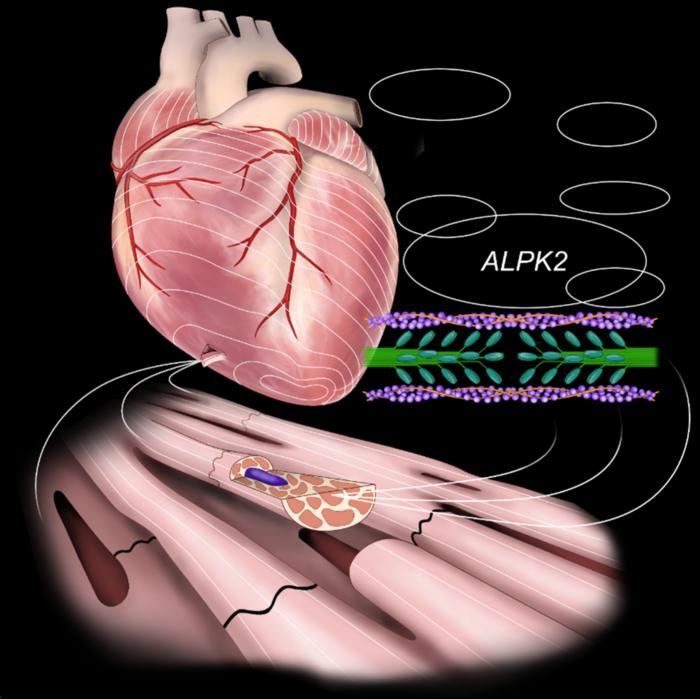In a groundbreaking study, researchers at Nagoya University Graduate School of Medicine have unveiled an exciting potential therapeutic target for a lethal and challenging form of heart failure known as heart failure with preserved ejection fraction (HFpEF). The enzyme identified, alpha-kinase 2 (ALPK2), shows promise in combating this increasingly prevalent condition characterized by a rigid heart that fails to relax adequately, thereby thwarting the proper filling of blood. This research offers a beacon of hope for the millions suffering from HFpEF, given the current limited treatment options available.
Heart failure has reached epidemic proportions globally, with a notable spike in the incidence of HFpEF, a particularly stubborn variant of the condition. Unlike its counterparts, HFpEF occurs when the heart maintains its ejection fraction—an indicator of the heart’s ability to pump blood—but struggles with relaxation during the diastolic phase. This impairment leads to decreased blood flow that fails to meet the physiological demands of the body. A hallmark of HFpEF patients is their experience of debilitating symptoms, which significantly compromise their quality of life.
Central to this study is the intricate mechanism of protein phosphorylation, a process crucial for regulating various physiological functions, including the heart’s pumping action. Proteins undergo modification through the addition of phosphate groups by enzymes known as protein kinases. This biochemical process alters the protein’s structure, affecting its function and interactions with other molecules. Disruptions in the activity of these enzymes can contribute to pathophysiological conditions such as a stiffened heart muscle.
The research team undertook a thorough investigation of the expression profiles of 518 distinct protein kinases, aiming to pinpoint those with specific relevance to cardiac physiology. Their efforts led to the identification of ALPK2, an enzyme that is not only unique to heart tissue but also plays a pivotal role in maintaining cardiac function. The discovery of ALPK2 as a heart-specific protein kinase piqued the interest of the researchers, which sparked further studies into its functional implications.
Utilizing mice as a model organism, the team compared the cardiomyopathic effects of ALPK2 deficiency with that of significant ALPK2 overexpression. The results were striking; animals lacking the gene necessary for ALPK2 synthesis displayed increased susceptibility to diastolic dysfunction, mirroring many of the clinical manifestations seen in aging-related heart diseases. In contrast, those with elevated levels of ALPK2 demonstrated marked improvements in cardiac compliance and relaxation, shedding light on the protective mechanisms at play.
A critical finding from this exploration was the phosphorylation of tropomyosin 1 (TPM1), a vital protein involved in cardiac contraction regulation. The researchers noted that HFpEF patients often exhibit diminished levels of TPM1, suggesting that pharmacological strategies aimed at increasing its phosphorylation could yield therapeutic benefits. With ALPK2 promoting this phosphorylation, the enzyme stands to play an integral role in fortifying cardiac function against the backdrop of HFpEF.
The research led by Tatsuya Yoshida and his colleagues concluded that the overexpression of ALPK2 could inhibit the progression of diastolic dysfunction—a precursor to heart failure. In experimental models, this intervention was correlated with improved lung weight, a commonly used metric for assessing the severity of heart failure. By mitigating fluid accumulation often seen in heart failure patients, ALPK2 has emerged as a key player in potentially reversing detrimental changes associated with the disease.
The implications of this research extend beyond immediate findings, offering a novel pathway for drug development targeting the ALPK2/TPM1 regulatory axis. Given the current landscape of HFpEF treatment options—limited to SGLT2 inhibitors and ARNI therapies—the introduction of ALPK2-related approaches holds promise for diversifying and enhancing therapeutic interventions. As ongoing investigations seek to unravel the full spectrum of ALPK2’s role, this discovery represents a significant stride toward innovative clinical applications.
Furthermore, the ability of ALPK2 to modify the phosphorylation status of TPM1 suggests a sophisticated mechanism of action that could potentially be harnessed in pharmacological formulations. This could lead to the creation of targeted therapies that not only aim to improve heart muscle flexibility but also address the underlying causes of diastolic dysfunction. Such developments could pave the way for more effective management strategies tailored to HFpEF, ultimately enhancing patient outcomes.
This finding marks an important milestone in cardiac research, echoing calls for renewed focus on heart failure mechanisms that specifically address heart relaxation. The recognition of ALPK2’s role in this process brings forth a new chapter in the quest for effective heart failure therapies. With further studies planned to investigate the translational potential of this discovery, the hope is that future interventions may soon translate into clinical realities that can significantly improve the prognosis for individuals grappling with HFpEF.
In conclusion, the discovery of ALPK2 as a promising therapeutic target signifies a breakthrough in understanding heart failure, particularly HFpEF. As researchers continue to unravel the complexities of cardiac function and dysfunction, the role of specific enzymes such as ALPK2 will undoubtedly continue to inform both clinical practice and therapeutic developments. The quest for innovative treatment strategies against heart failure remains a pressing priority, and ALPK2 represents a forward-thinking avenue worth exploring.
Subject of Research: Heart Failure and Therapeutic Targets
Article Title: ALPK2 prevents cardiac diastolic dysfunction in heart failure with preserved ejection fraction
News Publication Date: 18-Nov-2024
Web References: https://faeb.org
References: DOI 10.1096/fj.202402103R
Image Credits: © 2024 Federation of American Societies for Experimental Biology (FASEB).
Keywords: Heart Failure, ALPK2, HFpEF, Cardiology, Protein Kinases, Tropomyosin 1, Phosphorylation, Therapeutic Targets, Cardiac Dysfunction, Drug Development, Gene Therapy, Personalized Medicine.
Tags: ALPK2 therapeutic targetcardiac health innovationschronic heart failure symptomsdiastolic dysfunction researchenzyme alpha-kinase 2heart disease epidemicheart failure with preserved ejection fractionHFpEF treatment optionsmechanisms of heart relaxationNagoya University heart researchprotein phosphorylation in heart functionrigid heart syndrome





